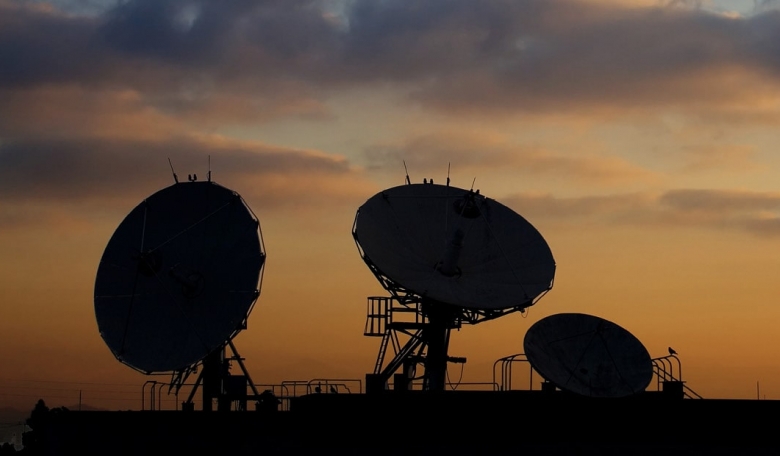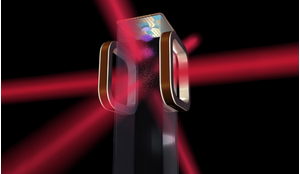To meet the growing consumer appetite for new mobile services and applications, and ease the strain placed on wireless networks because of the mobile data boom, the capacity and performance of these networks has had to evolve rapidly. Mobile network operators (MNOs) have invested in new technologies to fortify their networks and satisfy growing demand. Here, Semir Hassanaly explains how satellite cellular backhaul – the connection between cell towers and the rest of the network that facilitates mobile phone service – will play a pivotal part in future networks and growth opportunity in unserved or underserved regions where traditional terrestrial solutions are not practicable.
In our digital world, it is increasingly evident that the internet – and access to it – has become an absolute necessity. In most recent times, with technological advancements and the saturation of smart devices, it is mobile access that is at the forefront of this connectivity. It is so ingrained and influential in contemporary living, our infrastructure, processes and culture, that it is considered just as vital as electricity and running water.
And yet, almost half of the world’s population lacks access to the internet entirely, particularly in emerging regions, according to the International Telecommunication Union. This means that mobile network operators (MNOs) must work to bridge that gap and expand data capabilities into less accessible corners of the developed world or in unconnected rural areas. Traditional, terrestrial solutions, such as fibre or cable, are either prohibitively expensive or altogether impossible to deploy, considering the geographical footprint, lack of infrastructure and utilities, rugged terrain and low population density of these regions. Satellite technology, therefore, with its ability to provide instant wide coverage is ideally suited to close the communications gap.
 Increasingly, consumers are switching to their mobile devices to access and browse the internet, rather than using desktop computers or laptops.
Increasingly, consumers are switching to their mobile devices to access and browse the internet, rather than using desktop computers or laptops.
Unlocking potential
Satellite technology, with its ability to provide instant wide coverage is ideally suited to close the communications gap
The transformative nature of the internet is undeniable and impacts individual consumers and whole economies alike. With global demand for better connectedness and the rise of 5G, it is clear that satellite cellular backhaul – the connection between cell towers and the rest of the network that facilitates mobile phone service – will play a pivotal part in future networks and growth opportunity in the regions where traditional deployments have proved to be out of reach.
Research has shown that connectivity can have a life-changing impact for unconnected remote communities. The World Bank estimates that for every 10 percent increase in high-speed internet connections, a country’s gross domestic product rises approximately by 1.4 percent.
For example, in Asia, there are 775 million citizens that remain unconnected, often in isolated communities and living below the poverty line, with lack of access to many basic and critical services such as healthcare, education and connectivity. In remote African countries, the challenges of delivering high-speed internet connectivity are steep. Rural, middle populations are sparsely spread and often lack the economic potential to justify a viable business case for rolling out individual backhaul networks, as expenditure would be several times the amount of that in urban areas.
User behaviour has evolved and increasingly, consumers are switching to their mobile devices to access and browse the internet, rather than hard-wired desktop computers or laptops. The affordability and availability of smartphones has improved over the years and the convenience of having the World Wide Web at your fingertips, means that mobile traffic now accounts for more than half of all Web traffic. Data-hungry applications have also increased in popularity, such as instant messaging applications, social media platforms and on-demand video streaming services. To deliver the quality of service that consumers have come to expect when using applications such as these, a robust, efficient, scalable network is required.
Mobile backhaul via satellite provides a compelling business case and allows people to remain connected and keep pace with the fast-developing technology landscape, in areas where they have previously been left behind.
 Access to the internet is so much a part of modern life that it is considered an absolute necessity, and it is mobile access that is at the forefront of this connectivity.
Access to the internet is so much a part of modern life that it is considered an absolute necessity, and it is mobile access that is at the forefront of this connectivity.
Satellites changing lives on the ground
The transformative nature of the internet is undeniable and impacts individual consumers and whole economies alike
In Africa, Liquid Telecom, has utilised ST Engineering iDirect’s Dialog® platform to make bandwidth more affordable to businesses and consumers. Dialog is a multiservice satellite communications platform that allows service providers to access a wide range of markets, manage operational and capital costs effectively and create unique value for customers. It provides the scalability and flexibility required to run successful, very efficient satellite networks and allows satellite service providers to build and adapt their network easily as their business grows.
With this implementation, Liquid Telecom has provided African enterprises with cost-effective bandwidth for big-data applications. These applications rapidly interpret huge amounts of data which helps to boost efficiency and also to develop new data-driven products and services.
Telefonica – one of the largest MNOs in the world – has a strategy of selling wholesale satellite capacity to other operators and expanding coverage areas across Latin and Central America. Utilising satellite backhaul, Telefonica helps mobile operators bypass high capital costs and accelerates their timelines to build out services in those markets.
Dialog has also been used by broadband satellite operator, Kacific, for its new High Throughput Satellite (HTS), Kacific1, to significantly expand its broadband service delivery in underserved areas of South East Asia, New Zealand and the Pacific Islands. Kacific1 will deliver affordable, high-speed internet broadband to telecommunications companies, internet service providers and governments throughout the region.
The Kacific1 satellite features 56 high power subscriber spot beams, each with the capability to provide targeted capacity at high speeds. Kacific services enable access to high demand applications, such as community internet access and mobile backhaul, that will help stimulate socio-economic activity throughout the region.
Reducing the time and expense of installations in these remote areas, Dialog enabled Kacific to run a shared bandwidth platform spanning multiple satellites, depending on customers’ specific needs. As a result, Kacific can now provide access to a wealth of information and dedicated services and the social benefits of this connectivity cannot be underestimated or overstated. It paves the way to education, telemedicine, the ability to develop small businesses and to give access to financial services and potentially life-saving weather reports in areas that are beyond the economical reach of terrestrial infrastructures.
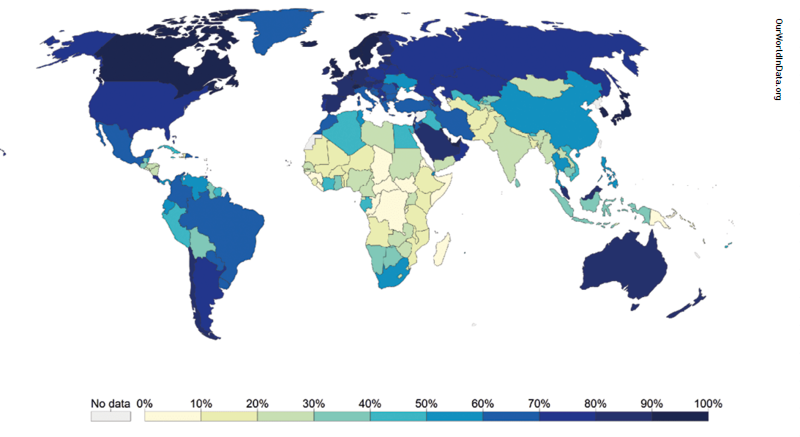 This visualisation shows the percentage of individuals using the Internet in each country in 2017, including hard-wired desk top computers, laptops and mobile devices. Almost half the world’s population has no access to the Internet and fewer than one in ten households in less economically developed countries world are connected.
This visualisation shows the percentage of individuals using the Internet in each country in 2017, including hard-wired desk top computers, laptops and mobile devices. Almost half the world’s population has no access to the Internet and fewer than one in ten households in less economically developed countries world are connected.
Covid-19 pandemic
Satellite technology has already proved itself as being highly adaptable for mobile backhaul purposes
The demand for connectivity and for a more connected world, and proof that it is at the very core of the day-to-day workings of life, has never been made clearer than during the Covid-19 crisis. As lockdown measures and restrictions were put in place around the globe, the demand for internet connection, VoIP (Voice over Internet Protocol) calls, video calls and over-the-top (OTT) content, such as video streaming applications for entertainment, rose exponentially.
Access to online services like food delivery, health services and online retail became critical. Connectivity has kept children learning at home when schools have been closed and enabled businesses to remain operational at a time when entire workforces have had to work from home and movement has been restricted. Isolated, vulnerable members of society have been able to stay connected to other members of the community and vital information and updates about the virus and measures in place to manage the spread of it, have been shared to larger audiences online.
It is in difficult times, like the Coronavirus health emergency, that the life-changing – and sometimes life-saving – impact of the internet and digital technologies can no longer be ignored. The lack of these things is often felt most profoundly by the most remote, poorest communities among us, and so the pressure for MNOs to connect the unconnected is mounting.
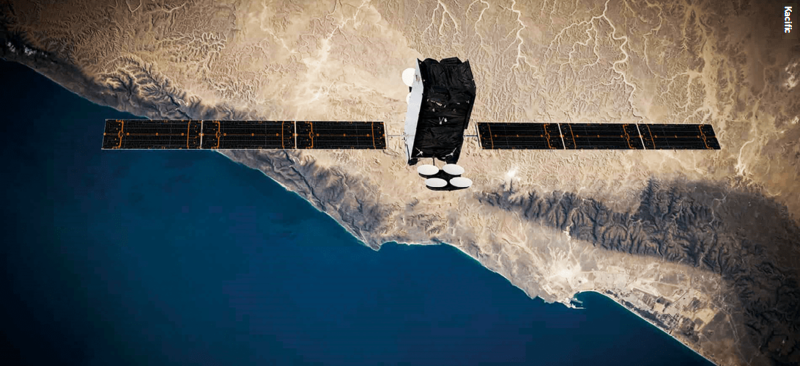 High Throughput Satellites offer the ability to support hundreds of megabits per second (Mbps) of capacity for backhaul, and are crucial in enabling service providers, telcos and MNOs to connect the unconnected and bridge the bandwidth gap between urban and unserved and under served areas.
High Throughput Satellites offer the ability to support hundreds of megabits per second (Mbps) of capacity for backhaul, and are crucial in enabling service providers, telcos and MNOs to connect the unconnected and bridge the bandwidth gap between urban and unserved and under served areas.
A new era
However, bridging the digital divide in the outmost rural corners of the world requires more than just technology. A continued partnership between satellite operators and MNOs is also key to creating opportunities and changing the landscape of the cellular connectivity market for the better. With satellite at their disposal, MNOs have more room to extend the reach of their services and address new use cases, such as critical connectivity for disaster response efforts and OTT content distribution. The popularity of mobile banking and finance applications is also on the rise and is only set to grow further.
Today’s new HTS constellations and intelligent ground networks offer the ability to support hundreds of Mbps of capacity for backhaul, along with attractive price points, and are crucial in enabling service providers, telcos and MNOs to not only connect the unconnected but also to bridge the bandwidth gap between urban, unserved and underserved areas.
As we enter the 5G era, satellite connectivity is particularly crucial for the next stage of the evolution for MNOs. In fact, Northern Sky Research (NSR) estimates that 5G-differentiated applications – such as 5G backhaul and hybrid networks – will generate close to one-third of net satellite capacity revenue growth in backhaul over the next 10 years. Satellite and terrestrial will work in a complementary way to unlock many use cases. This is due, in part, to the fact that 5G backhaul capacity demand will consume four to five times the bandwidth of a 4G site, according to NSR. Satellite technology has already proved itself as being highly adaptable for mobile backhaul purposes.
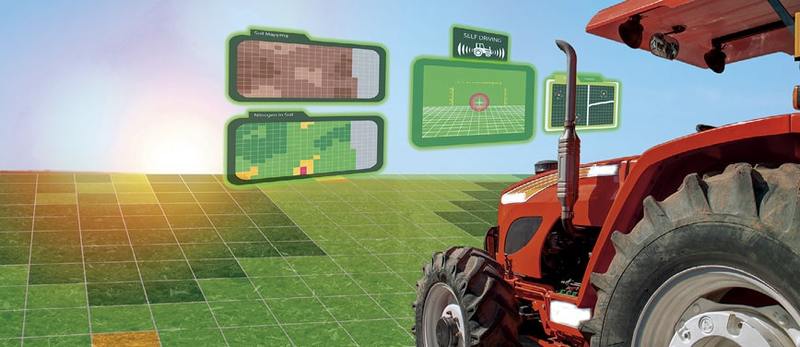 Connectivity delivered by new low Earth orbit (LEO) constellations is poised to transform the precision agriculture market.
Connectivity delivered by new low Earth orbit (LEO) constellations is poised to transform the precision agriculture market.
Connecting every corner
Research has shown that connectivity can have a life-changing impact for unconnected remote communities
The appetite for connectivity has never been so massive and the expectations placed on MNOs has never been higher or the competition so fierce. These factors intensify the challenges involved in expanding and diversifying mobile networks to provide quality remote and rural coverage beyond that of urban areas; as well as planning for the ubiquitous connectivity that the advent of 5G will require. However, where there are obstacles, there is opportunity. Satellite backhaul is one of the highest growth markets in the satellite space.
The dynamic nature of mobile network traffic requires a dynamic solution and satellite connectivity is more critical than ever to improve emergency response, manage data and surging video traffic volumes. The development of flexible, affordable and efficient satellite backhaul can help to meet the connectivity demands of not just today but also tomorrow.
To meet these heightened customer and business demands will require smarter use of satellite bandwidth, drawing from an expanded supply to augment services enabling operators to secure new subscribers and support new applications. By utilising satellites with cellular backhaul services to replace or supplement existing telecoms infrastructures in rural areas, operators can achieve greater coverage and remain competitive.
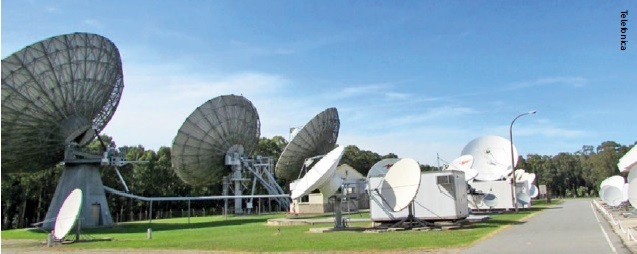 Utilising satellite backhaul, Telefonica plans to sell wholesale satellite capacity to other operators seeking to expand mobile services coverage into remote areas of Latin and Central America.
Utilising satellite backhaul, Telefonica plans to sell wholesale satellite capacity to other operators seeking to expand mobile services coverage into remote areas of Latin and Central America.
In order to ensure they serve their customers in an efficient way, operators should consider migrating their operations to one multiservice platform to allow them to serve numerous markets at the same time and grow their network with their business. More so, connecting the unconnected users in remote, rural areas will provide those markets with the same opportunities that are available in more developed regions – empowering communities, enabling innovation and creating connectivity for all.
About the author
Semir Hassanaly is Head of Cellular Backhaul & Trunking at ST Engineering iDirect, with expertise in mobile and internet business. Previously with Memotec, Semir was Vice President of Marketing & Strategy, and Product Marketing director at Comtech. Prior to this, he launched startups and held several international assignments with Oz Communications (acquired by Nokia), Airwide Solutions/Schlumberger & Sema Group in the areas of product management, solutions architecture and product development. Semir holds an MS in Electronics and Automatics from the University of Sciences of Montpellier, France, and an MS in Business Administration from the Institut Francais de Gestion, France.





